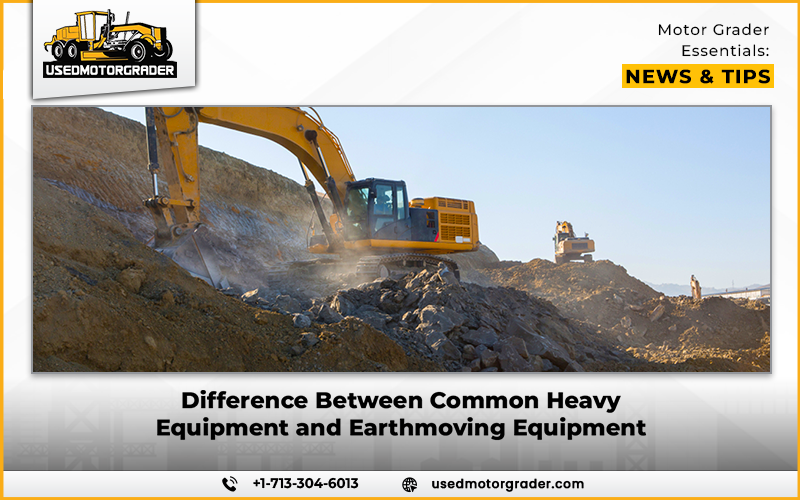Overlapping Terms, Different Purposes
In the construction and infrastructure world, people often use the terms “heavy equipment” and “earthmoving equipment” interchangeably. They overlap, but they are not exactly the same. The term “heavy equipment” refers to a broad range of machinery used in construction, agriculture, mining, and material handling sectors. Earthmoving equipment, however, is a particular subdivision of that grouping; equipment that is used to dig, move, or shape earth. Understanding the difference between the two goes beyond vocabulary; it plays a crucial role in selecting the right machine for the job, managing the fleet efficiently, and ensuring that operators receive the necessary training to meet their responsibilities.
What Is Considered Common Heavy Equipment?
The heavy equipment is the large and powerful machines that we find in almost all construction sites. These are the workhorses that lift, move, compact, or support structures and materials. Typical examples are cranes, forklifts, telehandlers, pavers, trenchers, and compactors. These are important construction logistics machines and support machines, but not necessarily directly earth-shaping machines. They are more versatile and usually more specialized in the processing of materials, the construction of infrastructure, or surface finishing. Their similarity lies in their size, strength, and capacity to perform industrial-level work that would have been impossible to accomplish with the help of manual labor, efficiently.
What Qualifies as Earthmoving Equipment?
A more specialized subset of heavy equipment is earthmoving equipment. These machines manipulate soil, rock, and other ground materials. Consider excavators that dig deep foundations, bulldozers that move dirt around a job site, or graders that smooth roads. This category also includes backhoes, skid steers with grading attachments, scrapers, and trenchers. The characteristic feature of these machines is that they engage the ground they cut, dig, grade, move earth, or load it. Site preparation is based on earthmoving equipment. They are the rough and heavy work machines, whether it be preparing a new building pad, carving a road through the terrain, or clearing land.
Functional Differences Between the Two Categories
The distinction between the common heavy equipment and the earthmoving machines is mostly on the basis of their functionality. Earthmoving equipment is specialized in terrain modification- digging, lifting the soil, moving rocks, and leveling. It is all about changing the landscape. In the meantime, typical heavy equipment is likely to serve building or logistic purposes: cranes carry steel beams, pavers complete asphalt roads, and compactors make sure that the soil or surface is solid. Other machines, such as wheel loaders or skid steers, may fall into either category based on attachments. However, in most cases, the earthmoving machines arrive first and clear the land before other things follow.
Equipment Design and Build Purpose
Manufacturers construct the earthmoving machines to resist the ground. They usually design them with strengthened frames, robust undercarriages, and high torque engines that can operate against heavy loads and rugged terrains. An example is the bulldozer, which has tracks and a front blade enabling it to push large quantities of material and still have traction. Graduates use long-wheelbase articulated frame machines to provide fine, angled blade control. In the meantime, engineers make the heavy equipment, such as cranes and telehandlers, in order to ensure stability during the lift and high-reach operations. They build them more on balance and extension than on earth contact.
Where Each Is Typically Used on the Jobsite
When you visit any jobsite, you will realize how the layout and schedule demonstrate the functions of every machine. Earthmoving machines appear first, addressing site preparation, excavation, or demolition. Excavators remove foundations, bulldozers remove vegetation and grade the land, and scrapers remove bulk materials. As the site develops, heavy equipment in general comes in to construct the real structure or to pave surfaces. Cranes hoist beams, telehandlers assist framing crews, and compactors complete subgrades with asphalt. The two types are vital in various phases of the project, but they also collaborate to ensure the project is on course.
How Equipment Overlaps and Complements Each Other
It is worth mentioning that not every equipment can be put in a single box. An example is skid steers, which may be compact earthmovers or material handlers depending on their attachments, augers, buckets, trenchers, or forks. The same applies to backhoe loaders that have both digging and lifting capabilities. This is why equipment roles are so helpful in project planning or fleet management. Sharing or rotating tools across jobs will result in less downtime, fewer duplicative machines, and more efficient use of operating budgets. Combining heavy and earthmoving equipment in most instances makes the jobsite more flexible and responsive.
Knowing the Difference Helps Maximize Equipment Use
When working in a busy construction setting, clarity is important. The distinction between heavy equipment and earthmoving equipment is not only a technicality. It is a practical benefit. It helps contractors choose the correct machine to use, ensures that trainers adequately train the operators, and enables fleet managers to make better purchase or rental decisions. Earthmoving equipment deals with the terrain; common heavy equipment constructs the next thing. They are the pillars of any successful project. Understanding their distinct roles and areas of overlap can enhance job site efficiency, safety, and project quality. Be it digging, lifting, loading, or finishing, the first thing to do is to use the right machine.


